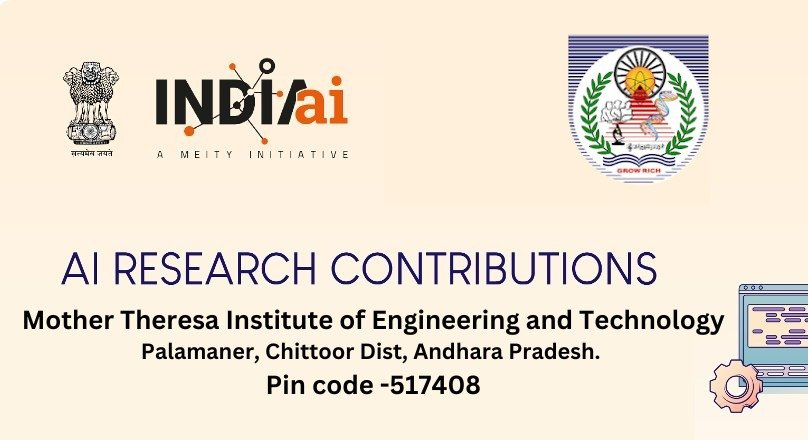Results for ""
The "INDIAai" National AI Portal of India offers weekly articles that showcase the AI research contributions of universities across the country. Each article provides an in-depth report on the work of a specific university, allowing researchers and students to present concise explanations of their research.
This week, the portal highlights the top AI research contributions from Mother Theresa Institute of Engineering and Technology, Palamaner, Chittoor, Andhra Pradesh, India.
Mother Theresa Institute of Engineering and Technology (MTIET) was established in 2010 by the Holy Cross Educational Society, Palamaner, to make engineering education accessible to rural and underprivileged youth. Located 5 km from Palamaner along the Chennai-Bombay National Highway, MTIET offers a serene and picturesque learning environment.
As one of seven institutions founded by the society, MTIET is dedicated to providing holistic technical education to the educationally underserved western mandals of Chittoor District. Since its inception, the institute has consistently demonstrated excellence in engineering education, fulfilling its commitment to empowering rural students.
The following are some of their AI research contributions:
Authors:
- Thirumalesu Kudithi, School of Technology, The Apollo University, Chittoor, India.
- J Balajee, Department of Computer Science and Engineering, Mother Theresa Institute of Engineering and Technology, Palamaner, Chittoor, Andhra Pradesh, 517408, India.
- R Sivakami, Department of Computer Science and Engineering, Sona College of Technology, Salem, 636005, India.
- T R Mahesh, Department of Computer Science and Engineering, JAIN (Deemed-to-Be University), Bengaluru, 562112, India.
- E Mohan, Department of ECE, Saveetha School of Engineering, SIMATS, Chennai, Tamilnadu, India.
- Suresh Guluwadi, Adama Science and Technology University, Adama, 302120, Ethiopia. suresh.guluwadi@astu.edu.et.
HybridPoseNet introduces a pioneering AI-based approach to diagnosing Ehlers-Danlos Syndrome (EDS) by providing accurate joint angle measurements through a hybrid deep learning model. Integrating CNNs with HyperLSTM units, the model effectively captures the dynamic nature of joint motion, offering superior generalization and time consistency. Preliminary results show significant improvements in correlation with manual goniometry, enhancing diagnostic accuracy by approximately 20%. This innovation represents a substantial advancement in the medical diagnostics of connective tissue disorders, simplifying and improving the assessment of joint hypermobility.
Rule-Based Mamdani Fuzzy Inference System to Analyze Efficacy of COVID-19 Vaccines
Authors:
- Poonam Mittal, J C Bose University of Science and Technology
- S P Abirami, Vellore Institute of Technology University
- Puppala Ramya, Koneru Lakshmaiah Education Foundation
- Balajee J, Mother Theresa Institute of Engineering and Technology
- Elangovan Muniyandy, Saveetha School of Engineering
This study introduces a novel approach using Mamdani Fuzzy System Modeling to assess the efficacy of COVID-19 vaccines, considering various epidemiological and clinical factors. The model evaluates eight key aspects of vaccine efficiency by analyzing data from research papers, news articles, and journals. The fuzzy inference system provides valuable insights for pharmaceutical manufacturers to enhance vaccine efficacy and aids in decision-making for vaccine selection. This approach offers a practical tool for improving vaccine effectiveness in real-world scenarios, contributing to better management of COVID-19.
Authors:
- Dr. Araddhana Arvind Deshmukh, Professor, School of Computer Science & Information Technology (Cyber Security), Symbiosis Skill and Professional University, Kiwale, Pune, India
- R.V.V. Krishna, ECE Department, Aditya College of Engineering &Technology, Aditya Nagar, Surampalem, India-533437
- Rahama Salman, Lecturer, Department of Information Technology and Security, College of Computer Science & Information Technology, Jazan University, Jazan, KSA
- S Sandhiya, Assistant Professor, Department of IT, Panimalar Engineering College, India
- Dr. Balajee J, Associate Professor, Department of Computer Science and Engineering, Mother Theresa Institute of Engineering and Technology, Palamaner- 517408, Chittoor, Andhra Pradesh, India
- Dr. Daniel Pilli, Assistant Professor, Department of MBA, Koneru Lakshmaiah Education Foundation, India
This paper presents an advanced AI-driven approach for liver disease classification using ultrasound imaging, highlighting the importance of early diagnosis and personalized treatment. The proposed CNN-ELM-GWO model integrates an Extreme Learning Machine (ELM), Convolutional Neural Network (CNN), and Grey Wolf Optimization (GWO) to enhance classification accuracy. By leveraging deep CNN for feature extraction and GWO for hyperparameter optimization, the model achieves a remarkable 99.7% accuracy, surpassing traditional machine learning methods by 27.5%. This innovative technique demonstrates significant potential in revolutionizing liver disease diagnosis and medical imaging practices.
Convolutional Neural Networks in Malaria Diagnosis: A Study on Cell Image Classification
Authors:
- Hritwik Ghosh, Vellore Institute of Technology University
- Irfan Sadiq Rahat, Vellore Institute of Technology University
- J V R Ravindra, Vardhaman College of Engineering
- Balajee J, Mother Theresa Institute of Engineering and Technology
- Mohammad Aman Ullah Khan, BRAC University
- J Somasekar, Jain University
This study explores the application of convolutional neural networks (CNNs) to improve the accuracy and speed of malaria detection by classifying infected cell images. By evaluating various deep learning models, including ResNet50, AlexNet, Inception V3, VGG19, VGG16, and MobileNetV2, the research identifies AlexNet and VGG19 as the top performers in terms of accuracy. The study emphasizes the importance of selecting models based on specific application needs, considering trade-offs between computational efficiency and performance. The findings highlight the significant potential of CNNs in advancing malaria diagnosis, with future research aimed at optimizing models, expanding datasets, and integrating CNNs into practical diagnostic tools.
Authors:
- P.C. Prabhu Kumar, Computer Science and Engineering Department, Mother Theresa Institute of Engineering and Technology, Palamaneru, AP, 517408, India
- T. Ramathulasi, Computer Science and Engineering Department, Mother Theresa Institute of Engineering and Technology, Palamaneru, AP, 517408, India
- P. Venkateswarlu Reddy, Computer Science and Engineering Department, Sree Vidyanikethan Engineering College, Rangampeta, Tirupathi, AP, India
This research proposes an innovative AI-driven fuel price monitoring framework to alleviate the financial burden on middle-class individuals caused by rising petrol and diesel costs. The system categorizes fuel prices into three tiers—premium, luxury, and economic-based on the vehicle's brand and cost, detected via FASTag RFID technology. IoT devices connected to fuel dispensers interact with a public cloud that processes vehicle data to determine the appropriate pricing tier. This smart pricing system demonstrates a novel approach to fuel cost management, potentially offering more equitable pricing than the existing uniform pricing structure.






